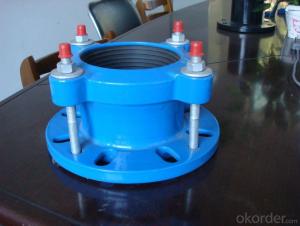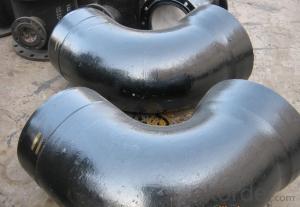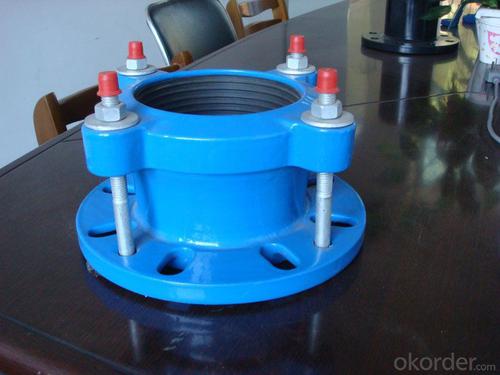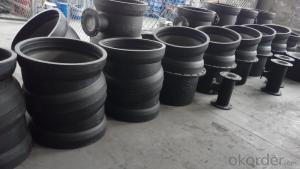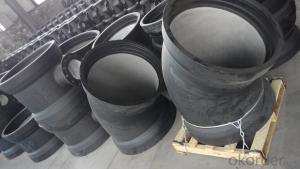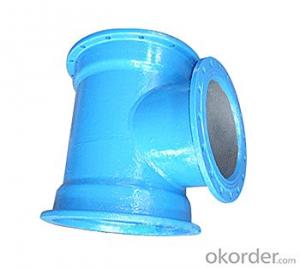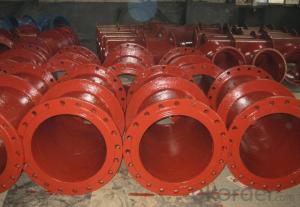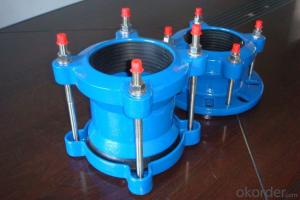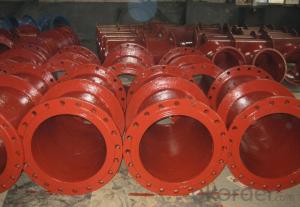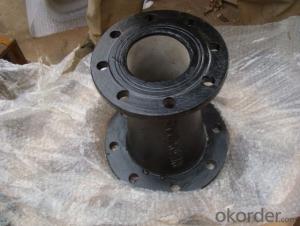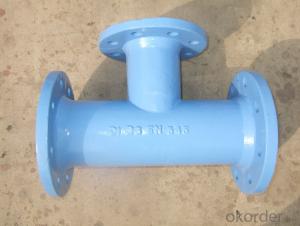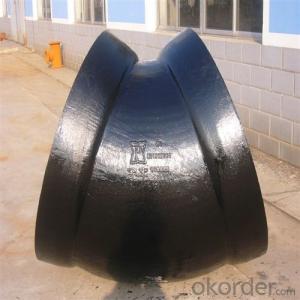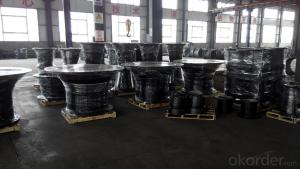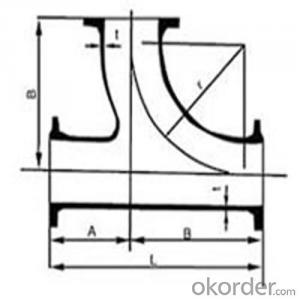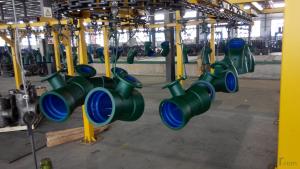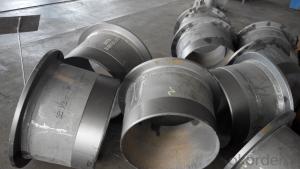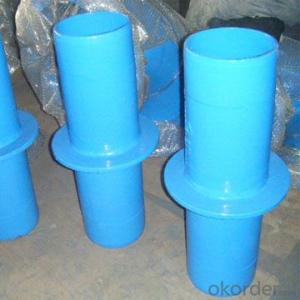Ductile Iron Pipe Fittings All Flanged Tee Cast Iron Pipe EN545 DN1400
- Loading Port:
- China main port
- Payment Terms:
- TT or LC
- Min Order Qty:
- 5 m.t.
- Supply Capability:
- 50000 m.t./month
OKorder Service Pledge
OKorder Financial Service
You Might Also Like
Ductile Iron Pipe Fittings Description :
Pipe fittings confirm to ISO2531,K9 class,T type joint,6m long,with inside cements lining conform to ISO4179, outside Zinc spraying(130g/m2) and bitumen coating(70μm) conform to ISO8179.
Pipe fittings ends: Spigot and socket ends, with 100% SBR rubber gaskets accoding to ISO4633
Main Features of the Ductile Iron Pipe Fittings:
1. Material: Ductile iron grade 500-7/ 450-10 in accordance with ISO1083
2. Standard: ISO 2531, EN545, EN598, ANSI, AWWA
3. Certificate: ISO9001, ISO14001, SGS, NSF, WRAS
4. Test: In accordance with ISO 2531 / EN 545 / EN598 and 100% water pressure test
5. Internal Lining: Cement, conform to ISO4179
6. Note: The gaskets, bolts & nuts are supplied respectively as your special requirement
Ductile Iron Pipe Fittings Images:
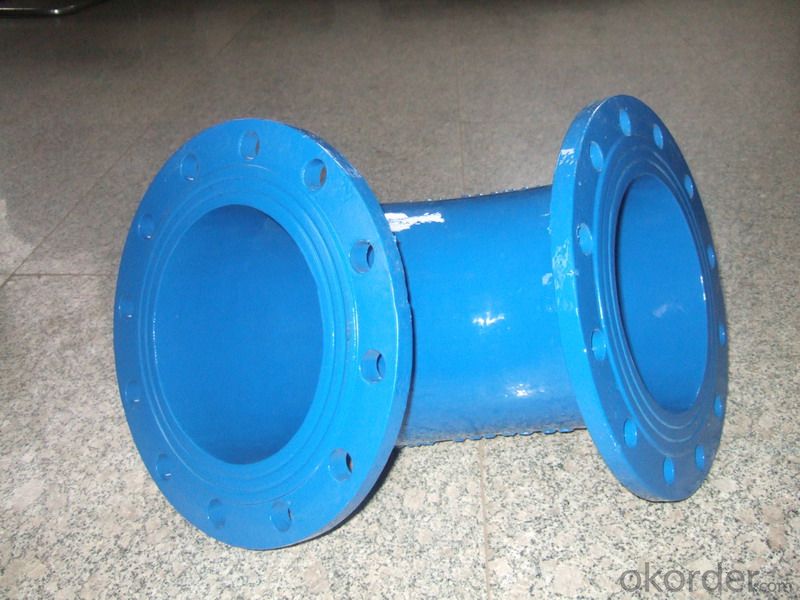
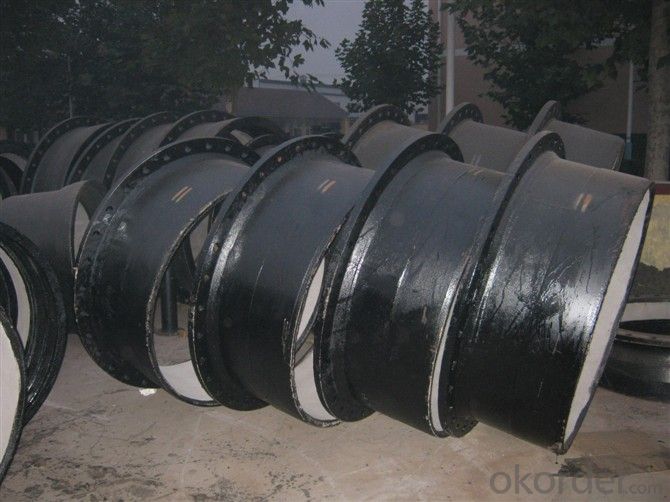
Ductile Iron Pipe Fittings Specification:
Place of Origin: China (Mainland)
Model Number: DN80-1600
Standard: ISO2531 / EN545
Application: Potable/Sewage Water
Diameter: DN80-1600
Yield (≥ MPa): 300
Material: Ductile Iron
FAQ:
We have organized several common questions for our clients,may help you sincerely:
1.Q:Why can you guarantee the inner of pipes can’t be corroded?
A: High alumina cement mortar lining and sulphate-resistant cement mortar lining. These two special linings are applicable to inner anti-corrosion for sewage pipes fittings, improving resistance to erosion of the sewage components.
2.Q: Why would you choose ductile iron pipe fittings rather than other pipe fittings materials?
A:The reasons are obvious for that not only ductile iron pipe fittings possesses the inherent strength and flexibility of ductile iron, combined with proven corrosion protection systems, but also the cost savings can be achieved from design to installation and commissioning.
- Q: I‘m talking about a halo spartan (with the armor abilities) vs. Iron man
- iron man vs spartan spartan war machine vs spartan war machine
- Q: I am trying to get a normal level of iron cuz Im always being told my iron low
- Recommended Daily Allowance (RDA) for Iron 0 to 6 months, 0.27 milligrams of Iron per day 7 - 12 months, 11 milligrams of Iron per day 1 -3 years, 7 milligrams of Iron per day 4 -8 years, 10 milligrams of Iron per day 9 to 13 years old, 8 milligrams of Iron per day Males 14 to 18 years old - 15 milligrams of Iron per day Females 14 to 18 years old - 18 milligrams of Iron per day Males 19 to 50 years old - 8 milligrams of Iron per day Females 19 to 50 years old - 18 milligrams of Iron per day Males and females 51 years and older, 8 milligrams of Iron per day Pregnant females all ages, 27 milligrams of Iron daily Lactating females age 14 to 18, 10 milligrams of Iron per day Lactating females over age 19, 9 milligrams of Iron per day
- Q: WHAT ARE 3 paragraphs about the iron lung
- Rick - The iron lung is an important part of medical history. By definition the iron lung is an airtight metal tank that encloses all of the body except the head and forces the lungs to inhale and exhale through regulated changes in air pressure. According to Robert Hall author of History of the British Iron Lung, the first scientist to appreciate the mechanics of respiration was John Mayow. In 1670, John Mayow demonstrated that air is drawn into the lungs by enlarging the thoracic (chest) cavity. He built a model using bellows inside which was inserted a bladder. Expanding the bellows caused air to fill the bladder and compressing the bellows expelled air form the bladder. This was the principle of artificial respiration called external negative pressure ventilation or ENPV that would lead to the invention of the iron lung and other respirators. The first modern and practical respirator nicknamed the iron lung was invented by Harvard medical researchers Philip Drinker and Louis Agassiz Shaw in 1927. The inventors used an iron box and two vacuum cleaners to build their first respirator. Almost the length of a subcompact car, the iron lung exerted a push-pull motion on the chest. In 1927, the first iron lung was installed at Bellevue hospital in New York City. The first patients of the iron lung were polio sufferers with chest paralysis. Entire hospital wards were filled with rows of iron lungs at the height of the polio outbreaks of the 1940s and 1950s. With the success of the worldwide polio vaccination programs which have virtually eradicated new cases of the disease, and the advent of modern ventilators that control breathing via the direct intubation of the airway, the use of the iron lung has sharply declined.
- Q: Iron from Iron Ore.
- Iron is extracted from its oxide ores, primarily hematite, by reduction with carbon monoxide in a blast furnace: Fe2O3 + 3CO ---- 2Fe + 3CO2 iron(III) oxide + carbon monoxide ---- iron + carbon dioxide Magnetite, which has the formula Fe3O4, can also be used: Fe3O4 + 4CO ---- 3Fe + 4CO2 Iron(II, III) oxide + carbon monoxide ---- iron + carbon dioxide The carbon monoxide is produced by partial combustion of coke (made by heating coal). Limestone is added to tie up silica impurities in the ore as calcium silicates: ex. CaCO3 + SiO2 ---- CaSiO3 + CO2
- Q: How can ductile iron pipes be connected to steel tubes?
- First insert a flange plate on the ductile iron pipe and then screw it with the flange on the weld pipe.
- Q: pleeeeease help. just a regular iron not some fancy thing
- IT OPENS THE VALVES MORE QUICKER JUST CHECK COOLING SYSTEM IT MITE RUN A LITTLE HOTTER
- Q: i have tried at least 4 times to do apheresis. and everytime, my iron levels have been too low to donate.what foods/drinks reduce the iron in the blood.
- Carbonated drinks, and caffeinated drinks lower iron, and so does smoking. The blood service has a food list in their brochure to pump up your iron level. I take a liquid iron supplement that suggests mixing it with orange juice to help the body absorb it, and not to eat or drink anything else 30 minutes before or after taking it. When you eat red meat, eat it with dark green veggies - and no starchy foods like rice, noodles or potatoes, or any dairy products.
- Q: Can iron react with iron sulfate?and can iron react with iron nitrate?
- Iron metal will not react with iron(II) sulphate, but it will react with iron(III) sulphate and iron(III) nitrate. Iron(II) nitrate does not exist. Fe + 2Fe3+ ------ 3Fe2+ As for tin, look up the positions of iron and tin in the electrochemical series. Tin will reduce iron(III) to iron(II) but no further, so it will not reduce iron(II) sulphate at all.
- Q: anemia and low iron and high erythropoietin
- What are you asking? Anemia is generally associated with a low amount of hemoglobin in the blood. Hemoglobin is the part of the red blood cell that holds iron and oxygen. Iron deficient anemia would result in low iron levels in your blood. Erythropoietin is a hormone released by the kidneys that stimulates erythropoiesis (red blood cell production).
Send your message to us
Ductile Iron Pipe Fittings All Flanged Tee Cast Iron Pipe EN545 DN1400
- Loading Port:
- China main port
- Payment Terms:
- TT or LC
- Min Order Qty:
- 5 m.t.
- Supply Capability:
- 50000 m.t./month
OKorder Service Pledge
OKorder Financial Service
Similar products
Hot products
Hot Searches
Related keywords
